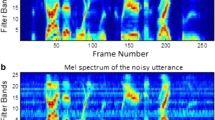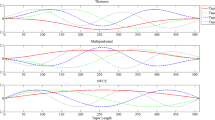Abstract
This paper brings an improvement of voice activity detection, based on vector quantization and speech enhancement preprocessing (VQ-VAD) proposed recently, and applied to speaker verification system under noisy environment. VQ-VAD is based on computing the likelihood ratio on an utterance-by utterance basis from mel-frequency cepstral coefficients that train speech and non-speech models. Whereas the notion of speech and non-speech segments in speech signal is independent of the speaker. For this, a modified VQ-VAD technique is proposed in this paper, by creating two UBM’s for speech and non-speech models, trained from a long utterance-independence model. Then, an adaptation of UBM’s models to the short utterance of speaker is performed via MAP adaptation, instead of using VQ models. Mel-frequency cepstral coefficient’s were also extracted by using the recently proposed asymmetric tapers instead of the traditional Hamming windowing. Using the GMM–UBM as a baseline system for speaker verification, extensive simulation results were done by adding different noise levels to the clean TIMIT database, characterized by its short training and very short testing utterances. The obtained results show the superiority of the proposed GMM-MAP-VAD approach in adverse conditions. Furthermore a drastic reduction in the EER is observed when using asymmetric tapers.


Similar content being viewed by others
References
Amrouche, A., Debyeche, M., Taleb-Ahmed, A., Michel Rouvaen, J., & Yagoub, M. C. (2010). An efficient speech recognition system in adverse conditions using the nonparametric regression. Engineering Applications of Artificial Intelligence, 23(1), 85–94.
Asbai, N., Bengherabi, M., Amrouche, A., & Harizi, F. (2013a). Improving speaker verification robustness by front-end diversity and score level fusion. In Proceedings of 2013 International Conference on Signal-Image Technology & Internet-Based Systems (SITIS) kyoto, Japan (pp. 136–142). IEEE.
Asbai, N., Bengherabi, M., Harizi, F., & Amrouche, A. (2013b). Improving the performance of speaker verification systems under noisy conditions using low level features and score level fusion. In International Conference on Signal Processing and Multimedia Applications (SIGMAP), Iceland (pp. 33–38). INSTICC.
Berouti, M., Schwartz, R., & Makhoul, J. (1979). Enhancement of speech corrupted by acoustic noise. In Acoustics, Speech, and Signal Processing, ICASSP’79 (Vol. 4, pp. 208–211). IEEE.
Dehak, N., Kenny, P., Dehak, R., Dumouchel, P., & Ouellet, P. (2011). Front-end factor analysis for speaker verification. Audio, Speech, and Language Processing, IEEE Transactions on, 19(4), 788–798.
Do, M. N. (2003). Fast approximation of Kullback–Leibler distance for dependence trees and hidden Markov models. Signal Processing Letters, IEEE, 10(4), 115–118.
Gauvain, J. L., & Lee, C. H. (1994). Maximum a posteriori estimation for multivariate Gaussian mixture observations of Markov chains. Speech and Audio Processing, IEEE Transactions on, 2(2), 291–298.
Gerkmann, T., & Hendriks, R. C. (2012). Unbiased MMSE-based noise power estimation with low complexity and low tracking delay. Audio, Speech, and Language Processing, IEEE Transactions on, 20(4), 1383–1393.
Gonzalez-Rodriguez, J., Drygajlo, A., Ramos-Castro, D., Garcia-Gomar, M., & Ortega-Garcia, J. (2006). Robust estimation, interpretation and assessment of likelihood ratios in forensic speaker recognition. Computer Speech & Language, 20(2), 331–355.
Kanungo, T., Mount, D. M., Netanyahu, N. S., Piatko, C. D., Silverman, R., & Wu, A. Y. (2002). An efficient k-means clustering algorithm: Analysis and implementation. Pattern Analysis and Machine Intelligence, IEEE Transactions on, 24(7), 881–892.
Kenny, P., Boulianne, G., Ouellet, P., & Dumouchel, P. (2007). Joint factor analysis versus eigenchannels in speaker recognition. Audio, Speech, and Language Processing, IEEE Transactions on, 15(4), 1435–1447.
Kinnunen, T., & Li, H. (2010). An overview of text-independent speaker recognition: From features to supervectors. Speech Communication, 52(1), 12–40.
Kinnunen, T., & Rajan, P. (2013). A practical, self-adaptive voice activity detector for speaker verification with noisy telephone and microphone data. In Proceedings of Acoustics, Speech and Signal Processing, 2013. ICASSP 2013. Canada, (pp. 7229–7233). IEEE.
Linde, Y., Buzo, A., & Gray, R. M. (1980). An algorithm for vector quantizer design. Communications, IEEE Transactions on, 28(1), 84–95.
Ma, B., Meng, H. M., Mak, M. W. (2007). Effects of device mismatch, language mismatch and environmental mismatch on speaker verification. In Acoustics, speech and signal processing, 2007. ICASSP 2007. IEEE International Conference on (Vol. 4, pp. IV-301).
Mak, M. W., & Yu, H. B. (2014). A study of voice activity detection techniques for NIST speaker recognition evaluations. Computer Speech & Language, 28(1), 295–313.
Martin, R. (2001). Noise power spectral density estimation based on optimal smoothing and minimum statistics. Speech and Audio Processing, IEEE Transactions on, 9(5), 504–512.
Morales-Cordovilla, J. A., Sánchez, V., Gómez, A. M., & Peinado, A. M. (2012). On the use of asymmetric windows for robust speech recognition. Circuits, Systems, and Signal Processing, 31(2), 727–736.
Reynolds, D. A., Quatieri, T. F., & Dunn, R. B. (2000). Speaker verification using adapted Gaussian mixture models. Digital signal processing, 10(1), 19–41.
Rozman, R., & Kodek, D. M. (2007). Using asymmetric windows in automatic speech recognition. Speech communication, 49(4), 268–276.
Varga, A., & Steeneken, H. J. (1993). Assessment for automatic speech recognition: II. NOISEX-92: A database and an experiment to study the effect of additive noise on speech recognition systems. Speech communication, 12(3), 247–251.
Author information
Authors and Affiliations
Corresponding author
Rights and permissions
About this article
Cite this article
Asbai, N., Bengherabi, M., Amrouche, A. et al. Improving the self-adaptive voice activity detector for speaker verification using map adaptation and asymmetric tapers. Int J Speech Technol 18, 195–203 (2015). https://doi.org/10.1007/s10772-014-9260-6
Received:
Accepted:
Published:
Issue Date:
DOI: https://doi.org/10.1007/s10772-014-9260-6




